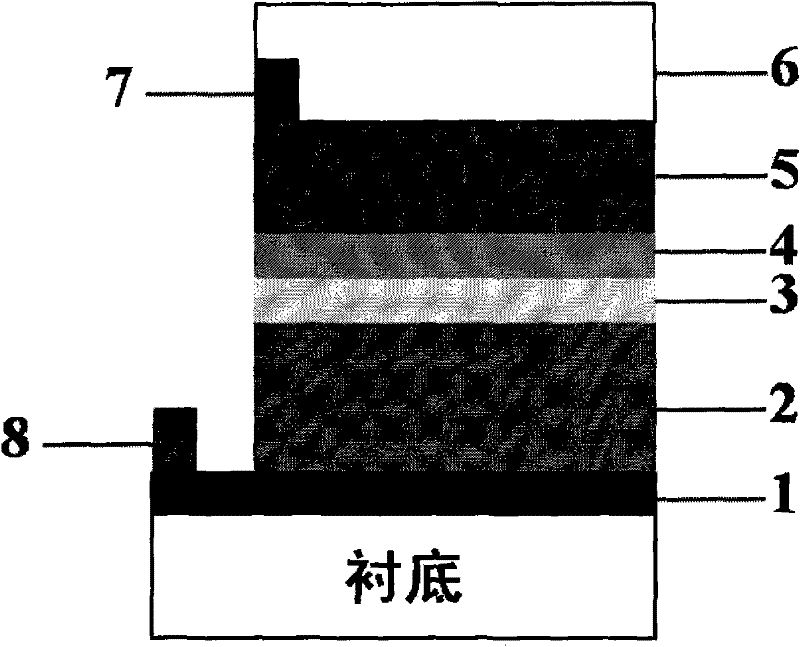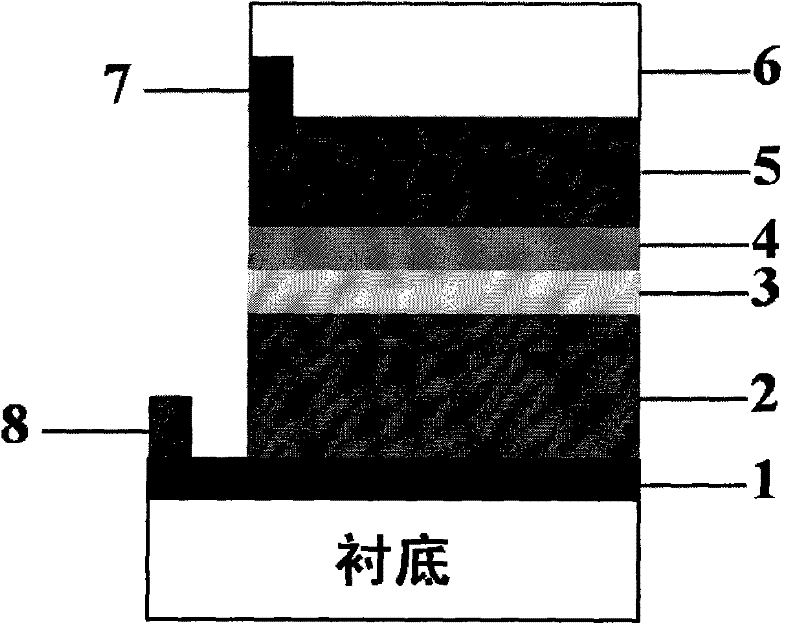I2-II-IV-VI4 base thin film solar battery
A thin-film solar cell, I2-II-IV-VI4 technology, applied in circuits, electrical components, photovoltaic power generation, etc., can solve the problems of low efficiency of base thin-film solar cells, unoptimized device structure, and insufficient ohmic contact, etc. , to achieve the effects of improving light utilization efficiency, improving charge collection ability, and high photoelectric conversion efficiency
- Summary
- Abstract
- Description
- Claims
- Application Information
AI Technical Summary
Problems solved by technology
Method used
Image
Examples
preparation example Construction
[0023] The ZnS thin film of the window layer is usually prepared by chemical bath deposition method, sputtering method or electron beam deposition method can also be used. The thickness of the thin film of the window layer is 50nm-200nm.
[0024] The transparent conductive layer is ZnO:Al or In 2 o 3 : Sn, generally prepared by magnetron sputtering, with a thickness of 100nm to 1500nm.
[0025] The interdigitated metal electrode is a Ni / Al double-layer electrode, which is generally prepared by evaporation or sputtering, wherein the thickness of Ni is 5nm-50nm, and the thickness of Al is 500nm-2500nm.
[0026] AR coating is MgF 2 , generally prepared by evaporation method, can also be prepared by sputtering method, the thickness is 50nm ~ 500nm.
Embodiment 1
[0029] Substrate: The substrate is ordinary soda-lime glass with a thickness of 2mm.
[0030] Bottom electrode: Cu 0.5 Zn 0.5 Te / Mo double-layer composite film, prepared by magnetron sputtering method, wherein the sputtering power density of Mo is 5Wcm -2 , Cu 0.5 Zn 0.5 The sputtering power density of Te is 1.5Wcm -2 , where Mo film thickness is 800nm, Cu 0.5 Zn 0.5 The thickness of the Te film was 50 nm.
[0031] Light-absorbing layer: Cu is used for the light-absorbing layer 1.6 Zn 1.1 sn 0.9 S 1.6 Se 2.4 The preparation of the semiconductor thin film and the absorption layer adopts the co-sputtering of Cu, ZnS and SnS to prepare the precursor film with a thickness of 1000nm, and then heat-treats at 570°C for 30min in the atmosphere of S and Se to form a Cu with a thickness of 1200nm. 1.6 Zn 1.1 sn 0.9 S 1.6 Se 2.4 semiconductor film.
[0032] Buffer layer: A 20nm thick ZnS thin film and a 5nm thick SnS film were prepared on the surface of the light absorbi...
Embodiment 2
[0039] Substrate: The substrate is ordinary soda-lime glass with a thickness of 2mm.
[0040] Bottom electrode: Cu 0.6 Zn 0.4 Te / Mo double-layer composite film, prepared by magnetron sputtering method, wherein the sputtering power density of Mo is 5Wcm -2 , Cu 0.6 Zn 0.4 The sputtering power density of Te is 1.5Wcm -2 , where Mo film thickness is 1200nm, Cu 0.6 Zn 0.4 The thickness of the Te film was 20 nm.
[0041] Light-absorbing layer: Cu is used for the light-absorbing layer 1.6 ZnCd 0.1 sn 0.9 S 3.2 Se 0.8 The preparation of the semiconductor film and the absorption layer adopts the organic colloid solution method, dissolving the iodide of Cu, Zn, Cd, Sn in the organic solvent of alcohol amine multifunctional group, and then adding anhydrous ammonium sulfide and anhydrous ammonium selenide to form The organic colloid source solution of Cu, Zn, Cd, Sn, S and Se is then cast into a film, dried at 350°C for 5min and heat-treated at 580°C for 30min in an argon atm...
PUM
 Login to View More
Login to View More Abstract
Description
Claims
Application Information
 Login to View More
Login to View More - R&D
- Intellectual Property
- Life Sciences
- Materials
- Tech Scout
- Unparalleled Data Quality
- Higher Quality Content
- 60% Fewer Hallucinations
Browse by: Latest US Patents, China's latest patents, Technical Efficacy Thesaurus, Application Domain, Technology Topic, Popular Technical Reports.
© 2025 PatSnap. All rights reserved.Legal|Privacy policy|Modern Slavery Act Transparency Statement|Sitemap|About US| Contact US: help@patsnap.com


